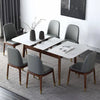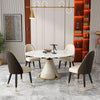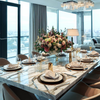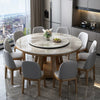How to Choose the Right Solid Wood Dining Table for Your Home
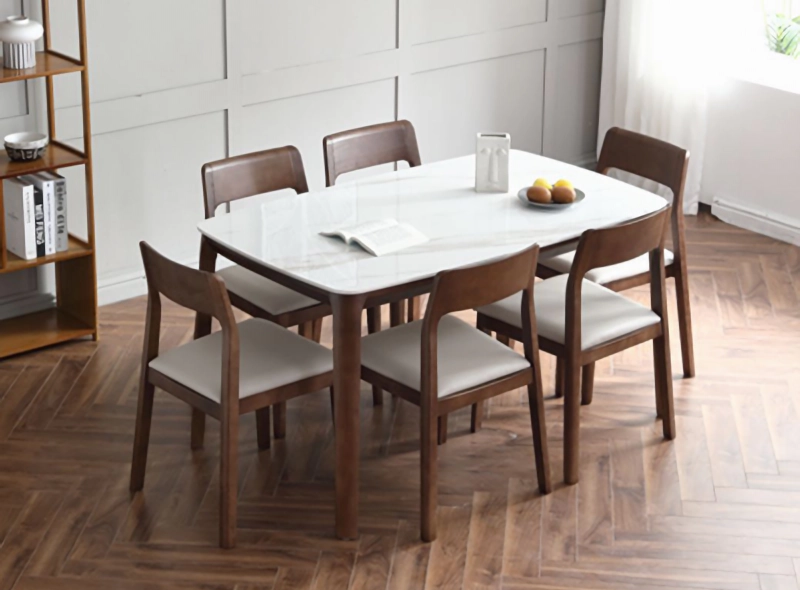
Introduction:
The dining table holds a place of honor in home decor, serving not just as a spot for meals, but as a gathering point for family discussions, holiday celebrations, and memorable conversations. It's more than just furniture; it embodies the essence of home and hospitality, making its choice a pivotal decision for any interior design. Solid wood dining tables, in particular, stand out for their unmatched blend of durability and aesthetics. Choosing solid wood means investing in a piece that can withstand the test of time and daily use, all while adding a touch of natural beauty to your dining area. The organic grains, the warmth of the wood, and the craftsmanship involved in creating a solid wood table contribute to a space that feels grounded and inviting. The benefits of solid wood extend beyond its robustness; it offers a timeless appeal that engineered woods cannot replicate, ensuring that your dining table remains a central, cherished piece in your home for years to come. This introduction to solid wood dining tables highlights not only their functional importance but also their role in enhancing the overall ambiance and aesthetic appeal of your dining space.
Understanding Solid Wood
When it comes to selecting the perfect dining table for your home, understanding the material is crucial. Solid wood stands as a preferred choice for many, thanks to its durability, timeless beauty, and the warmth it brings to any space. Here, we delve into the various types of solid wood used in dining tables and compare solid wood with engineered wood to help you make an informed decision.

Types of Solid Wood Used in Dining Tables
- Pine: Known for its affordability and rustic charm, pine is a softwood that brings a cozy, warm feel to your dining area. Its light color palette and the ability to absorb stains well make it a versatile option for various decor styles. Pine's natural knots and grain patterns add character and a touch of the outdoors to your home.
- Oak: Renowned for its durability and rich grain patterns, oak is a hardwood that lends a traditional look to dining tables. Its resistance to wear makes it an ideal choice for a family dining table that will see daily use. Oak tables can come in a range of colors, from light to dark, depending on the finish, complementing both modern and classic interiors.
- Maple: Maple is a light-colored hardwood known for its strength and versatility, making it suitable for a contemporary style dining area. Its smooth grain and uniform appearance allow it to fit seamlessly into minimalist decor or serve as a subtle backdrop for more vibrant accents. Maple's durability ensures that your table remains a staple in your dining room for years.
- Walnut: If you're looking for a dark, luxurious statement piece, walnut is the way to go. This hardwood boasts a rich, deep color and intricate grain patterns that command attention and add sophistication to your space. Walnut tables are not only beautiful but also robust, capable of withstanding the demands of everyday use and aging gracefully.
Solid Wood vs. Engineered Wood
When comparing solid wood to engineered wood, two main factors stand out: longevity and authenticity. Solid wood dining tables are celebrated for their longevity, capable of lasting generations with proper care. The authenticity of solid wood, with its unique grain patterns and natural imperfections, brings a level of character and warmth that engineered woods simply can't match.
Furthermore, solid wood is a better investment over time. While engineered wood might offer a cost-effective solution upfront, solid wood tables maintain their value and can even become heirloom pieces. The ability to refinish and repair solid wood tables also adds to their longevity, making them a more sustainable choice for those looking to make a long-term investment in their home decor.
Choosing a solid wood dining table means investing in quality, durability, and beauty that will enhance your home for many years to come. Whether you're drawn to the rustic charm of pine, the traditional elegance of oak, the contemporary appeal of maple, or the luxurious depth of walnut, solid wood offers unmatched benefits that make it a superior choice for your dining space.

Factors to Consider When Choosing a Solid Wood Dining Table
Selecting the right solid wood dining table for your home involves more than just falling in love with its appearance. It requires careful consideration of various factors that will ensure the table not only fits perfectly into your space but also meets your lifestyle needs. For more insights on seamlessly integrating your dining table with your living room decor, explore our comprehensive guide on choosing the right dining table for your living room. Here’s what to keep in mind:
Size and Shape
- Measuring Your Dining Space: Before you start shopping, measure your dining area. You'll want to ensure there's enough room for chairs and for people to move around comfortably. A good rule of thumb is to allow at least 36 inches between the table's edge and the walls or any other furniture.
- Round vs. Rectangular vs. Square Tables: The shape of your table can affect both the functionality and flow of your room. Round tables are great for smaller spaces and promote conversation, as everyone sits an equal distance apart. Rectangular tables are the most common and fit well in long, narrow spaces, while square tables work well in square rooms and can create a sense of symmetry and balance.
Style and Design
- Traditional, Modern, Rustic, and Contemporary Designs: The style of your dining table should complement your home's existing decor. Traditional tables often feature intricate designs and dark wood finishes. Modern tables lean towards minimalism with sleek lines and may incorporate mixed materials. Rustic tables embrace a more natural look, often with unfinished wood and a rugged appearance. Contemporary tables are versatile, featuring updated designs that blend elements from both modern and traditional styles.
- Matching Your Table with Your Home's Existing Decor: Consider the overall theme and color scheme of your home. A solid wood table should enhance your space, not clash with it. Pay attention to the details of your dining area and choose a table that aligns with the existing aesthetic, whether it’s a specific design era or a more eclectic approach.
Wood Finish and Color
- Natural, Stained, or Painted Finishes: Solid wood tables come in a variety of finishes. Natural finishes showcase the wood’s original grain and color, stained finishes can deepen or alter the color while still showing the grain, and painted finishes provide a uniform color that can either blend with your decor or add a pop of contrast.
- Choosing the Right Color for Your Dining Area's Palette: The color of your table should harmonize with the color palette of your dining area. Whether you choose a wood that’s close to your flooring for a cohesive look or select a contrasting color for a statement piece, ensure it complements the room's overall tone and style.
Durability and Maintenance
- The Importance of Craftsmanship in Solid Wood Furniture: High-quality craftsmanship not only affects the table’s aesthetic but its longevity as well. Look for tables made with traditional joinery techniques, such as dovetail or mortise and tenon joints, which indicate a piece is built to last.
- Tips for Maintaining Your Solid Wood Dining Table: To preserve the beauty and integrity of your solid wood table, regular maintenance is key. Dust it with a soft, dry cloth and clean spills immediately to prevent stains. Protect the surface from heat and scratches by using placemats or tablecloths, and consider applying a natural oil or wax periodically to enhance the wood’s natural beauty and protect its surface.
Choosing a solid wood dining table is an investment in both the style and function of your home. By considering these factors, you can select a table that not only fits your space and lifestyle but also stands the test of time, becoming a cherished piece in your home for years to come.

How to Choose the Perfect Size and Shape
Choosing the right size and shape for your solid wood dining table is crucial in maximizing both the functionality and aesthetic appeal of your dining space. Here are key guidelines to ensure you select a table that perfectly suits your needs and room dimensions:
- Measure Your Dining Room’s Dimensions: Start by measuring the length and width of your dining area. Knowing the exact dimensions will help you understand the maximum table size your space can accommodate without feeling cramped.
- Allow 36 Inches Between the Table and Walls for Chairs and Movement: To maintain a comfortable flow around your dining area, ensure there is at least 36 inches (about 91 cm) of space between the edge of the table and the walls or any other furniture. This clearance is necessary for pulling out chairs and allowing people to move around easily without feeling squeezed.
- Consider Extendable Tables for Flexible Dining Options: If your dining area serves multiple purposes or you occasionally host large gatherings, an extendable table could be an ideal solution. Extendable tables offer the flexibility to adjust the table size according to your immediate needs, providing more space when you have guests and saving space when not in use.
Selecting the perfect size and shape for your dining table not only enhances the room's functionality but also contributes to the overall harmony and balance of your dining space. Whether you opt for a round, rectangular, or square table, remember that the right choice depends on your room’s dimensions, your lifestyle needs, and how you plan to use the space.
Selecting the Right Wood Type for Your Table
The type of wood you choose for your dining table can significantly impact both its appearance and longevity. Understanding the characteristics of different woods and selecting one that best suits your durability needs and aesthetic preferences is essential. Here’s a breakdown to guide you through this selection process:
Understanding Wood Characteristics
- Grain: The grain of the wood refers to the pattern of its fibers. This can vary widely between species, affecting the texture and visual appeal of the table. Some woods have a straight grain, while others may be wavy or have unique patterns, adding character to your dining table.
- Hardness: The hardness of the wood affects its durability and resistance to scratches and dents. Hardwoods, like oak and walnut, are more durable and better suited for a piece of furniture that will see heavy use, such as a dining table.
- Color Variations: Wood naturally comes in a range of colors, from light maple to dark walnut. These colors can deepen or change over time, especially when exposed to sunlight. Choosing a wood color that complements your dining room’s color scheme is important for creating a cohesive look.
Best Woods for Durability
- Oak: Oak is highly valued for its strength and durability, making it one of the most popular choices for dining tables. It has a pronounced grain pattern, which adds depth and character to the table’s appearance. Oak tables can last for decades with proper care, making them a wise investment for a family dining table.
- Teak: Teak is renowned for its exceptional durability and resistance to water and rot, making it an excellent choice for both indoor and outdoor dining tables. Its natural oils protect the wood, and it has a smooth grain with a golden-brown color that can beautifully age into a silvery-gray patina if left untreated.
- Walnut: Walnut is a strong, hard wood with a rich, dark color that makes it stand out as a statement piece in any dining room. It has a fine grain that adds elegance and sophistication to the table. Walnut’s durability is comparable to oak, ensuring that your table will withstand the rigors of daily use for many years.
Selecting the right wood type for your dining table is a crucial decision that affects not only the piece’s aesthetic appeal but also its functionality and longevity. By understanding the characteristics of different woods and considering your needs for durability, you can choose a wood type that not only looks beautiful but also stands the test of time.

The Importance of High-Quality Craftsmanship
When investing in a solid wood dining table, the quality of craftsmanship not only influences the piece's aesthetic appeal but also its durability and longevity. Understanding what sets high-quality craftsmanship apart can help you make an informed choice, ensuring that your table can be a cherished part of your home for generations.
Identifying Quality Craftsmanship
- Joinery Types: The method used to join pieces of wood together in furniture construction is a key indicator of quality. Dovetail and mortise and tenon joints are renowned for their strength and durability, as well as the skill required to execute them. Dovetail joints, often used in drawers, involve interlocking wedge-shaped cuts that provide a tight fit without the need for nails or screws. Mortise and tenon joints, a hallmark of quality table construction, consist of a protruding tenon that fits into a corresponding mortise, creating a strong, enduring connection that can withstand heavy loads and the test of time.
- The Significance of Table Base and Leg Construction: The stability of a dining table largely depends on the design and construction of its base and legs. A well-crafted table should stand firm and level, without wobbling. Attention to the base and leg construction, including the use of sturdy materials and secure joinery, reflects the overall quality of the table. The design should not only be aesthetically pleasing but also functional, providing ample legroom and support for the tabletop.
Custom vs. Mass-Produced Tables
- Custom Tables with Sintered Stone Tops and Wood Bases: Beyond the traditional solid wood dining table, customizing your piece with a sintered stone top and wood base offers a modern, durable solution that beautifully blends natural materials. Sintered stone, known for its resistance to scratches, stains, and heat, pairs elegantly with the warmth and organic texture of a wood base. This combination allows for a high degree of customization in terms of colors, finishes, and sizes, ensuring your dining table is perfectly tailored to your space and style preferences. Explore our collection of sintered stone top with wood base dining tables to discover the ideal customizable option for your home, where functionality meets elegance in a design that's uniquely yours.
- Mass-Produced Tables: While there are high-quality mass-produced tables available, the manufacturing process for these items often prioritizes efficiency and cost-saving over meticulous craftsmanship. This can result in the use of lesser-quality materials or construction techniques that may not stand the test of time. However, advancements in technology and manufacturing have improved the quality of some mass-produced furniture, offering good value and design to those on a tighter budget or timeline.
The craftsmanship of your solid wood dining table impacts not just its look and feel but also its functionality and lifespan. By prioritizing quality craftsmanship, whether in a custom piece or a carefully chosen mass-produced table, you invest in a piece of furniture that can be enjoyed for many years and possibly even handed down through generations.

Maintenance Tips for Your Solid Wood Dining Table
A solid wood dining table can be a significant investment for your home, and with the right care, it can last for generations. Here are some essential maintenance tips to help preserve the beauty and integrity of your solid wood dining table:
- Regular Cleaning and Dusting Practices: Dust your solid wood dining table regularly with a soft, dry cloth to remove dust particles that can scratch the surface over time. For cleaning, use a slightly damp cloth and a mild cleaner specifically designed for wood furniture. Avoid using all-purpose cleaning sprays, as they can leave a filmy residue that dulls the wood finish. Always wipe in the direction of the grain to prevent scratches.
- Protecting the Surface from Heat and Scratches: Use placemats, tablecloths, or coasters to protect your dining table from hot dishes, cutlery, and abrasive objects. Direct heat can cause the wood to warp or create unsightly marks, while sharp objects can scratch the finish. If you’re using decorative items or centerpieces, consider placing felt pads underneath to avoid scratching the table surface.
- Oiling or Waxing to Enhance the Wood’s Natural Beauty: Depending on the finish of your table, applying a quality oil or wax can help to nourish the wood and keep it looking its best. This should be done every six months to a year, depending on the level of use and exposure to sunlight. Oiling helps to replenish the wood’s natural oils, keeping it hydrated and preventing it from drying out and cracking. Waxing adds a protective layer to the surface, enhancing the wood’s natural grain and giving it a soft sheen. Always test any product on a small, inconspicuous area first to ensure it does not damage the finish.
By following these maintenance tips, you can help ensure that your solid wood dining table remains a beautiful and durable centerpiece in your home for many years to come. Regular care not only preserves the table’s appearance but also its functionality, allowing it to continue serving as a gathering place for meals, conversations, and cherished moments.

Where to Buy Solid Wood Dining Tables
When it comes to purchasing a solid wood dining table, there are several avenues to explore. Each option offers distinct advantages and considerations, whether you prefer the personalized service of custom furniture makers, the convenience of online shopping, or the tactile experience of in-store purchases. Understanding the pros and cons of each can help you make the best choice for your needs and preferences.
Retailers vs. Custom Furniture Makers
- Retailers: Buying from retailers offers the convenience of seeing a wide range of styles and finishes in one place. Retailers often have both online and physical stores, providing flexibility in how you shop. The main advantages include immediate availability and often, the option for delivery and assembly services. However, the downside can be limited customization options, and the quality may vary depending on the retailer and the manufacturers they source from.
- Custom Furniture Makers: Opting for a custom furniture maker allows you to have a say in every aspect of your dining table, from the type of wood to the design and finish. This personalization ensures that the table fits perfectly with your home décor and meets your specific needs. The craftsmanship involved usually means a higher quality piece that can last generations. The cons include a higher price point, longer wait times for your table to be made, and the need for a more hands-on approach in the design process.
Online vs. In-Store Shopping
- Tips for Buying Solid Wood Furniture Online:
- Research the Seller: Look for reviews and ratings to gauge the quality of their products and customer service.
- Understand the Return Policy: Ensure the policy is flexible in case the table doesn’t meet your expectations.
- Ask for Detailed Descriptions and Images: Get as much information as possible about the wood type, construction details, and finish. High-quality photos from different angles and under various lighting conditions can provide a better sense of the table’s true appearance.
- Inquire About Shipping and Assembly: Solid wood tables can be heavy, so check if the seller offers delivery and assembly services, and if there are additional costs involved.
- Measure Your Space: Before ordering, double-check the dimensions of the table and your dining area to ensure a good fit.
For those looking to buy a solid wood dining table online, DPhome offers a standout option with the ability to customize your table to perfectly fit your space and style. With the added benefits of free shipping and the convenience of a showroom in Malaysia, DPhome provides an exceptional shopping experience. Whether you're looking for a unique piece tailored to your specifications or want to see the quality up close before making a purchase, DPhome caters to all your needs, ensuring your new dining table is everything you've envisioned.
Choosing where to buy your solid wood dining table depends on your priorities, whether it's customization, convenience, price, or the ability to inspect the table in person before making a purchase. By considering the pros and cons of each option and following tips for online shopping, you can find a solid wood dining table that you'll love for years to come.
Conclusion:
In conclusion, choosing the right solid wood dining table is a crucial decision that can significantly impact the ambiance and functionality of your home. As we've explored, considerations such as the type of wood, size and shape, style and design, as well as the craftsmanship, play pivotal roles in finding a table that not only meets your dining needs but also enhances your living space. A solid wood dining table is not just a piece of furniture; it's a central hub for gathering, sharing meals, and creating memories with loved ones.
We encourage you to carefully consider your specific needs and the overall style of your home when selecting a dining table. The beauty and durability of solid wood, combined with high-quality craftsmanship, can offer a timeless piece that transcends trends and becomes a cherished part of your home for generations. Remember, the right dining table can complement your home's decor, reflect your personal style, and withstand the test of time, making it a worthwhile investment for any homeowner.
As you embark on this decision-making journey, prioritize your needs, reflect on your personal style, and do not compromise on the quality of craftsmanship. By doing so, you'll ensure that your solid wood dining table will be a beautiful, functional, and enduring addition to your home.
FAQs
What are the benefits of choosing a solid wood dining table over other materials? Solid wood dining tables offer unparalleled durability, timeless beauty, and the unique ability to age gracefully. Unlike tables made from engineered wood or other materials, solid wood can withstand years of use while maintaining its structural integrity and aesthetic appeal. Additionally, solid wood tables can be refinished or repaired, allowing them to remain a central piece in your home for generations.
How do I determine the best size and shape for my solid wood dining table? The best size and shape for your dining table depend on the dimensions of your dining area and how you plan to use the space. Measure your dining room to ensure a good fit, leaving at least 36 inches between the table and walls for easy movement and chair access. Choose a shape that complements the room’s layout: round tables for smaller spaces or promoting conversation, rectangular tables for large dining areas, and square tables for square rooms to create balance.
Can I customize my solid wood dining table if I buy from DPhome? Yes, DPhome specializes in customizable solid wood dining tables, allowing you to select the wood type, finish, size, and design that best fits your space and style preferences. This level of customization ensures that your dining table is a unique, personalized piece that perfectly complements your home.
What maintenance is required to keep my solid wood dining table in good condition? Regular cleaning with a soft, dry cloth and immediate attention to spills can help protect your table’s surface. To prevent scratches and heat damage, use placemats or coasters. Depending on the finish, applying a quality wood oil or wax every six months to a year can enhance the wood’s natural beauty and protect it from drying out.
Is it better to purchase a solid wood dining table in-store or online? Both options have their advantages. Purchasing in-store allows you to see and feel the table before buying, ensuring you’re happy with the quality and craftsmanship. Buying online from reputable retailers like DPhome offers convenience, customization options, and often, benefits like free shipping. If possible, visit DPhome’s showroom in Malaysia to experience the quality firsthand before making your online purchase.


